
Diagnosing Pistol Malfunctions – Part 3: Failure to Eject
Diagnosing Pistol Malfunctions – Part 3: Failure to Eject
Welcome back and thank you for returning to read the final installment in the Diagnosing Pistol Malfunctions series. To cover the wide range of topics in this series, I have broken the 8 elements of the cycle of operation into the three commonly accepted types of pistol malfunction. Part 1, Failure to Feed covered the first three elements: feeding, chambering, and locking. Part 2, Failure to Fire, covered the fourth and fifth elements: firing and unlocking. In Part 3, Failure to Eject, we will discuss the remaining three elements within the cycle of operation: extracting, ejecting, and cocking. Within this category of stoppages, I will analyze the three main causes: (1) failure to extract; (2) double feed; and (3) stove pipe.
As we begin this discussion, I believe it is important to once again emphasize the preeminent role of the extractor and highlight its counterpoise with the ejector. In both Part 1 and Part 2 of the series, I described the extractor’s role in properly guiding a cartridge case along the breech face during the feeding cycle as well as its role in firmly holding the cartridge in place centering the primer in front of the firing pin hole.
 In Part 3, we will discuss the extractor’s profound role as the extractor claw “grips” the cartridge rim as the firearm unlocks and the rearward movement of the slide “extracts” the spent cartridge case from the chamber. As the slide continues its full rearward movement, the extractor maintains proper tension on the cartridge case holding it in position against the breech face until the continued rearward motion thrusts the base of the cartridge case against the ejector. Working in unison, the extractor continues to pull as the ejector pushes the spent cartridge case through the ejection port and away from the pistol… just in time for the slide to begin its forward motion which will feed the next round.
In Part 3, we will discuss the extractor’s profound role as the extractor claw “grips” the cartridge rim as the firearm unlocks and the rearward movement of the slide “extracts” the spent cartridge case from the chamber. As the slide continues its full rearward movement, the extractor maintains proper tension on the cartridge case holding it in position against the breech face until the continued rearward motion thrusts the base of the cartridge case against the ejector. Working in unison, the extractor continues to pull as the ejector pushes the spent cartridge case through the ejection port and away from the pistol… just in time for the slide to begin its forward motion which will feed the next round.
Failure to Extract

A brief visual inspection of the extractor claw can indicate excessive wear, damage, or a clean break. The photo to the right compares two 1911 extractors. One clearly has a broken claw. The only remedy to this problem is a full replacement. The good news is that most manufacturers produce quality extractors that are very affordable. They can range from $15.00 to $45.00 depending on the “name brand” you go with. Wilson Combat 1911 extractors are in the mid-$30.00 range and Glock extractors are just under $20.00. Since these are such an important item, it is a good idea to keep a spare extractor or two in your range bag.
When designed internal to the slide, such as most 1911s, the extractor is typically a solid piece of steel with a claw protruding into the breech. A “bow” in this solid piece of steel provides tension to the cartridge case. As such, the internal extractor itself can be considered a spring. The degree of the “bow” determines how much or how little tension is applied to the cartridge case.
When designed external to the slide, such as Glocks and Sigs, the extractor is one or more pieces of metal also with a claw protruding into the breech. External extractors rely on leverage and a spring to provide proper tension.
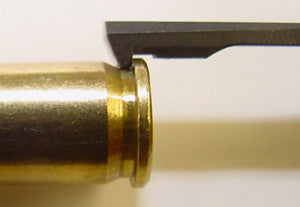 Whether internal or external, too much extractor tension may cause a failure to feed, but too little extractor tension could cause both a failure to feed and a failure to extract. In the case of a failure to extract, there just isn’t enough tension at the extractor claw to pull the case from the chamber. A visual inspection may not allow you to ascertain proper extractor tension.
Whether internal or external, too much extractor tension may cause a failure to feed, but too little extractor tension could cause both a failure to feed and a failure to extract. In the case of a failure to extract, there just isn’t enough tension at the extractor claw to pull the case from the chamber. A visual inspection may not allow you to ascertain proper extractor tension.
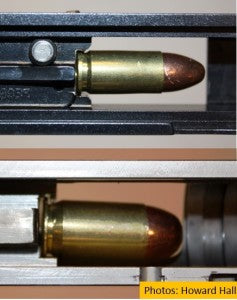 If you recall from previous discussions, proper extractor tension can be determined by removing the slide from your pistol and pushing a loaded cartridge case against the breech face with the case rim under the extractor claw. Once in place, shake the slide in your hand. The cartridge should remain in place. If it falls free, there may be insufficient extractor tension.
If you recall from previous discussions, proper extractor tension can be determined by removing the slide from your pistol and pushing a loaded cartridge case against the breech face with the case rim under the extractor claw. Once in place, shake the slide in your hand. The cartridge should remain in place. If it falls free, there may be insufficient extractor tension.
If you determine you have insufficient extractor tension, I recommend conducting a detailed disassembly and cleaning of your slide. Built-up dirt may be limiting the movement of your extractor and its parts. If cleaning the extractor, channel, and springs does not correct the problem, then you may need to modify or change some parts. If you have a one-piece internal extractor, you can “bend” it a little further inward to increase the “bow,” and thus the tension. If you have an external extractor, you may need to replace the springs.
Double Feed
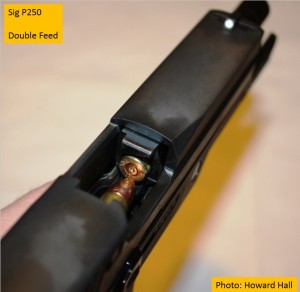 A double feed is one of the most difficult stoppages to clear… especially under pressure. “Tap… Rack… Assess” will either fail to correct the problem or create yet another double feed. It requires you to lock the slide to the rear, remove the magazine, “rack” the slide repeatedly to remove any cartridges, reinsert the magazine, and then chamber another round.
A double feed is one of the most difficult stoppages to clear… especially under pressure. “Tap… Rack… Assess” will either fail to correct the problem or create yet another double feed. It requires you to lock the slide to the rear, remove the magazine, “rack” the slide repeatedly to remove any cartridges, reinsert the magazine, and then chamber another round.
But what causes it?
The first potential cause is the continuation of the previous stoppage… failure to extract. In this case, the extractor failed to grasp the spent cartridge case as the slide moved to the rear. When the slide returned forward, it stripped a new cartridge from the magazine and attempted to chamber it… only to slam into the previously fired cartridge still lodged in the chamber. In this instance, repeat the corrective actions listed above: (1) conduct a visual inspection of the extractor claw to determine excessive wear or damage; and (2) check for proper extractor tension.
The other potential cause is shooter induced. This happens when something interrupts our mental and physiological process while on the firing line. We chamber a live round, but do not fire it for some reason. As we resume shooting, we begin to chamber another round, but do not pull the slide all the way to the rear, which pushes one round into the chamber which is already occupied. This simply requires the aforementioned clearing procedures.
Stove Pipe
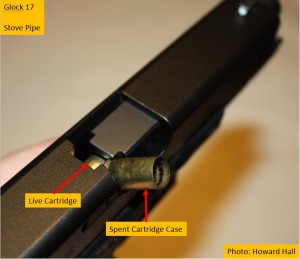 Named after the similarity to the outline of a home with a stove’s pipe sticking out of the roof, a stove pipe stoppage occurs when a spent cartridge case becomes trapped between the slide and the barrel hood. The standard “Tap… Rack… Assess” may not consistently clear this stoppage since, as you can see in the photo, a fresh cartridge has already been stripped from the magazine and is in the process of being chambered. Simply tapping the magazine and pulling the slide may actually induce a double feed. Clearing this stoppage requires the shooter to rake the non-shooting hand across the top of the pistol toward the body to force the trapped case free from the slide.
Named after the similarity to the outline of a home with a stove’s pipe sticking out of the roof, a stove pipe stoppage occurs when a spent cartridge case becomes trapped between the slide and the barrel hood. The standard “Tap… Rack… Assess” may not consistently clear this stoppage since, as you can see in the photo, a fresh cartridge has already been stripped from the magazine and is in the process of being chambered. Simply tapping the magazine and pulling the slide may actually induce a double feed. Clearing this stoppage requires the shooter to rake the non-shooting hand across the top of the pistol toward the body to force the trapped case free from the slide.
But what causes it?
In nearly all cases the slide is cycling faster than the case can be completely ejected. The potential causes span the gamut from pistol mechanics, ammunition induced, or shooter induced.
Pistol mechanics –
- If the recoil spring is too heavy, it will cycle the slide faster than the cartridge can clear the ejection port. Ensure that the tension of your recoil spring is matched to the type of ammunition you are shooting.
- An extractor with insufficient tension may not hold the cartridge case against the breech face tight enough for the ejector to thrust it through the ejection port in time for the slide to return forward. Perform the steps listed above to ascertain proper extractor function.
- A worn or damaged ejector may not provide enough thrust to propel the cartridge case through the ejection port in time for the slide to return forward. A visual inspection of the ejector may reveal excessive wear or damage.
Ammunition –
- Firing under-powered ammunition may not provide enough “force” to send the slide to the rear with sufficient momentum to allow the extractor and ejector to properly interact and propel the cartridge case through the ejection port with enough time for the slide to return forward. Ensure your recoil spring and ammunition are appropriately balanced.
- Dirty cartridge cases or worn cartridge rims may prevent the extractor from functioning properly. Ensure that your cartridges are clean, free from debris, and have well-defined rims.
Shooter Induced –
- Limp Wristing is the act of improperly gripping the pistol and allowing it to move too freely during the recoil cycle. The pistol’s recoil and mainsprings were designed to control the rearward movement of the slide and return it forward with enough force to strip the next round from the magazine, chamber it, and lock the barrel in place. The shooter must maintain a firm grip on the pistol frame in order to allow the springs within the pistol to do their work properly. Limp wristing the pistol absorbs too much recoil and can cause the slide to “short stroke,” and thus “catch” the spent casing before it is fully clear of the slide.
-
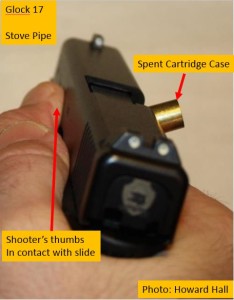 If the slide contacts the shooter’s clothing, a wall, or a barrier, this contact can slow or stop the slide’s rearward movement causing a “short stroke” which prevents the spent casing from clearing the ejection port.
If the slide contacts the shooter’s clothing, a wall, or a barrier, this contact can slow or stop the slide’s rearward movement causing a “short stroke” which prevents the spent casing from clearing the ejection port. - “Thumb Riding” occurs when the shooter inadvertently places his or her thumbs along the slide, which induces friction and can cause a “short stroke.”
Conclusion
With any luck, there was some information within this series to help you become a better shooter. Whether for recreation, competition, or personal defense, understanding the root causes of malfunctions and stoppages can only enhance your abilities to prevent malfunctions and correct them more rapidly when they do occur.
After all, firearms are simply machines. These machines are designed and made by people and are operated by people. There is certainly a possibility of a design and manufacturing defect. But there is also a possibility of improper maintenance and operation. Through this series, I hope you had an opportunity to objectively view the potential for both… and how to correct them.
The Latin phrase “know thyself” was inscribed into the Temple of Apollo at Delphi. In many ways, this Delphic maxim holds true for shooters today. As we have seen in this series, many root causes of pistol stoppages and malfunctions are shooter induced. Only under pressure do most shooters admit that they were limp wristing, thumb riding, riding the slide stop, failed to fully insert the magazine, or didn’t properly clean and maintain their pistols. Seeking shooting instruction, shooting with a coach, or shooting with a friend can help you identify many of the “shooter induced” malfunctions. Taking the time to properly clean, maintain, and replace springs on a regular basis can eliminate other malfunctions. Admittedly, this will not eliminate ALL malfunctions, but it will narrow the list of possibilities considerably, and help you bring any remaining issues to a gunsmith.
Just remember, the mind is like a parachute… it only works when it is open!
Stay safe and shoot straight
– Howard Hall
Leave a comment
Comments will be approved before showing up.
Also in Staff Articles

Home Defense - What you can do...

Gun Review: Sig Sauer P938
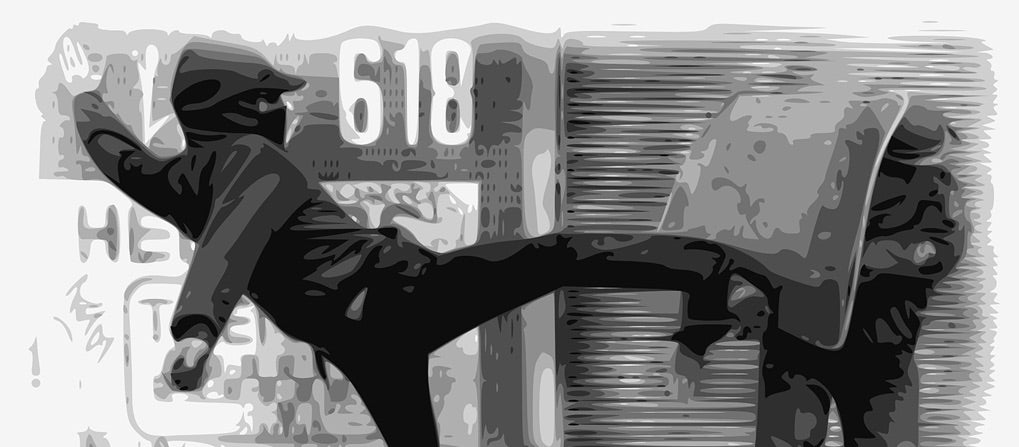

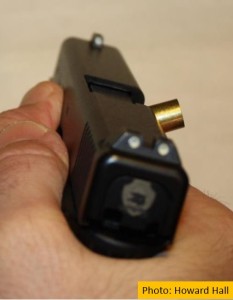
 If the slide contacts the shooter’s clothing, a wall, or a barrier, this contact can slow or stop the slide’s rearward movement causing a “short stroke” which prevents the spent casing from clearing the ejection port.
If the slide contacts the shooter’s clothing, a wall, or a barrier, this contact can slow or stop the slide’s rearward movement causing a “short stroke” which prevents the spent casing from clearing the ejection port.
Howard Hall
Author